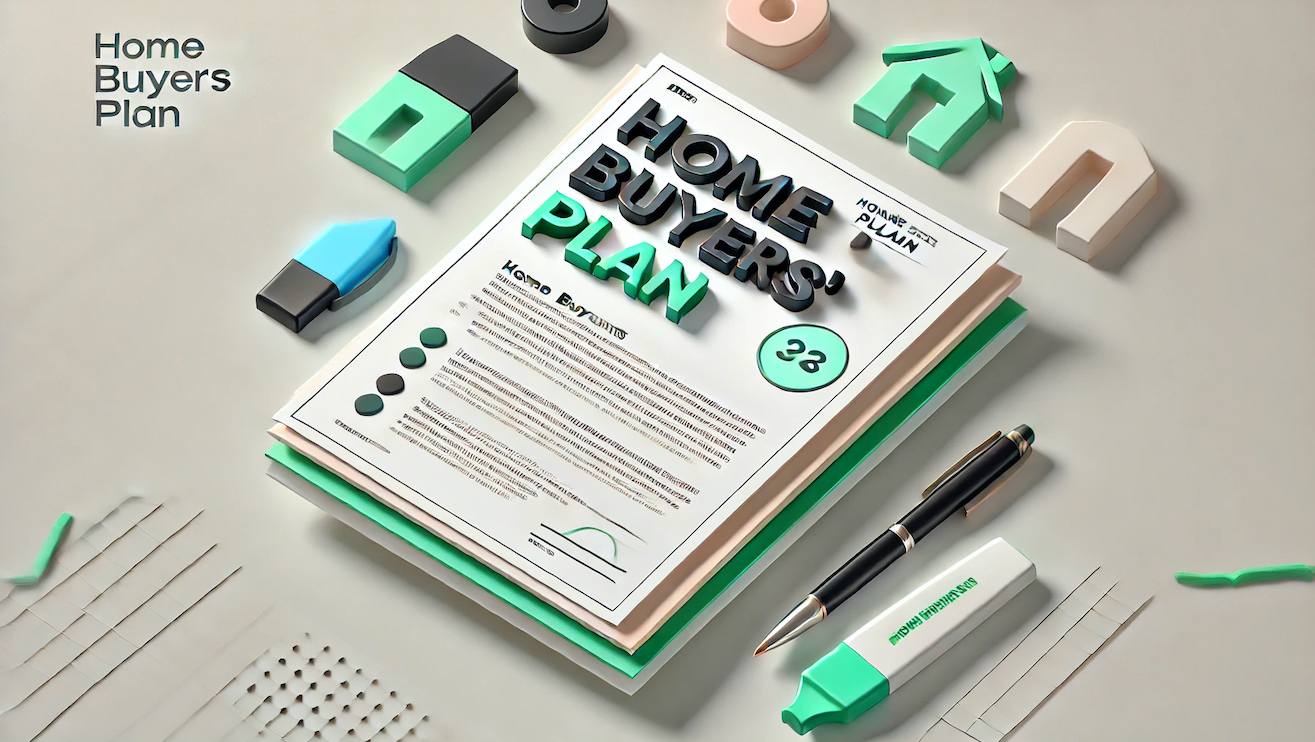Homeownership is a cornerstone of the Canadian dream, but for many first-time buyers, the path to that white picket fence can be daunting.
The average home price across Canada in August 2024 was $649,100, while the most recent data on household income suggested the average Canadian family earns around $87,700 a year, after taxes. Buying a home is tough these days in Toronto, even with a six-figure household income, saving for a downpayment on an average home can take 25 years.
Enter the Home Buyers' Plan (HBP), a federal program designed to boost aspiring homeowners by allowing them to tap into their Registered Retirement Savings Plans (RRSPs) to cover the cost of a down payment. As of 2024, eligible individuals can withdraw up to $60,000 from their RRSPs or $120,000 for couples and potentially unlock their first home sooner than they thought possible.
In this guide, we'll walk you through the ins and outs of the Home Buyers' Plan, detailing who it's best for, and what to consider. Whether you're a young professional looking to plant roots or a late-career first-time buyer, this article will help you navigate the complexities of the HBP and make an informed decision about your path to homeownership.
Home Buyers' Plan At a Glance
This program essentially allows you to borrow from your future self, creating a delicate balance between achieving your homeownership goals and maintaining your long-term financial health. As such, it's crucial to understand not just the mechanics of the HBP but also its implications for your overall financial picture. While the HBP offers an enticing opportunity, it's not a one-size-fits-all solution. Here's a quick overview of the key points:
- Withdrawal limit: As of April 16, 2024, eligible individuals can withdraw up to $60,000 from their RRSPs, and couples buying together can withdraw up to $120,000 combined.
- Tax-free withdrawal: The amount withdrawn under the HBP is not taxed at the time of withdrawal, provided you are able to pay everything back during the repayment period.
- Window before repayments: Normally, repayments begin two years after the year of withdrawal. However, for withdrawals made between January 1, 2022, and December 31, 2025, the repayment start has been extended to five years.
- Repayment period: After the repayment window ends, you have up to 15 years to repay the amount withdrawn to your RRSP.
- Annual repayment: The minimum annual repayment is 1/15th of the total amount withdrawn. For example, if you withdrew $60,000, you'd need to repay at least $4,000 per year. Though, if you overcontribute one year, the next year will be smaller.
- Consequences of non-repayment: If you don't repay the minimum amount in a given year, the shortfall is added to your taxable income for that year.
Pros and Cons of the HBP Program
The Home Buyers' Plan (HBP) offers first-time homebuyers a unique opportunity to use their RRSP savings for a down payment. But like any financial decision, it comes with both advantages and drawbacks. While we have a separate article detailing the pros and cons in depth, here's a high-level overview: Pros Cons Access up to $60,000 ($120,000 for couples) Tax-free withdrawal if repaid Interest-free borrowing Flexible repayment options Delayed repayment start (for 2022-2025 withdrawals) Combinable with other programs, like the FSHA Limited eligibility 15-year repayment obligation Tax consequences for missed repayments The opportunity cost of withdrawn funds Potential impact on retirement savings Complex rules and repayment schedule
| Pros | Cons |
|---|---|
|
|
Ideal Candidates for the HBP
The Home Buyers' Plan (HBP) can be a powerful tool for first-time homebuyers, but it's particularly beneficial for certain individuals. You might be an ideal candidate for the HBP if:
- You have substantial RRSP savings to withdraw from
- Your job and income are stable enough to handle 15 years of repayments
- You're looking to enter the housing market sooner rather than later
- You're financially and emotionally prepared for homeownership responsibilities
- You're buying a home for a disabled family member
1. You Have Substantial RRSP Savings
Have you been diligently saving in your RRSP for years? If so, the HBP could be your ticket to homeownership. By using up to $60,000 from your RRSP (or $120,000 for a couple), you could make a more significant down payment. This helps you avoid mortgage insurance, avoiding additional fees.
Making a down payment of 20% or more of the home's purchase price is particularly advantageous. With this larger down payment, you can avoid the requirement for mortgage default insurance, which is mandatory for down payments of less than 20%.
This insurance protects the lender and can cost between 2.8% and 4% of the mortgage amount, potentially saving you thousands of dollars over the life of your mortgage. Additionally, a larger down payment can result in better interest rates from lenders, further reducing your long-term costs.
2. You Have Job Stability and Can Stomach up to 15 Years of Repayment
If you decide to use the HBP, you'll need to make consistent repayments over 15 years if you want to avoid adding to your tax bill. This means the HBP is best if you have a stable job and income you can count on. If you're in a career where you feel secure and see potential for growth, you're in a good position to handle these repayments. Think of the HBP as a long-term investment in your future home, backed by your career stability.
However, also consider your age, as younger first-time buyers might have more time to rebuild their retirement savings. For example, Sarah, a 28-year-old software developer with a stable job and good prospects for income growth, might find that using the HBP could help her buy a home sooner. She has 15 years to repay the withdrawal. Once she's done, she'll be 43, and she'll still have over two decades to rebuild her RRSP.
Older buyers don't have the luxury of time, but they often do have more stable careers and higher incomes. Consider Mark, a 52-year-old franchise owner who is thinking of using the HBP for his first home purchase. It'll be easier for him to keep up with payments, but he'll be paying back the money until he's 67 after many people decide to retire.
3. You Want to Get Into The Market Sooner
Canada's real estate landscape has been dynamic in recent years, with many regions experiencing significant price increases. For instance, in Toronto, where housing prices have risen by 42% over the past five years, using the HBP might help you enter the market sooner before prices climb further out of reach.
However, in slower or declining markets like Woodstock and Brantford, it might be worth considering whether your urgency to buy outweighs the potential hit to your retirement savings. In a smaller city with stable prices, you might decide that it's better to keep the money invested in stocks.
4. You're Ready For Additional Homeownership Costs and Responsibilities
Buying a home is more than just changing your monthly rent to a mortgage payment. It's a big life step with new responsibilities and costs. The HBP works well for people who are ready for this commitment and are prepared for long-term ownership.
Let's break it down with some real numbers. For a home priced at $1,100,000 purchased with a 20% down payment in the Greater Toronto area, your monthly costs might look something like this:
- Mortgage payment: $5,038
- Property tax: $655
- Home insurance: $104
- Utilities: $340
- Internet/TV: $195
- Home maintenance fund: $1,880
That adds up to about $8,248 per month quite a jump from most rental situations! But it's not just about the money. It's about being ready to deal with everything from choosing paint colours to handling surprise repairs. If you're excited about putting down roots and creating a space that's truly yours, even with these added responsibilities, then using the HBP to get there could be a smart move.
5. You Are Buying For A Disabled Family Member
The Home Buyers' Plan (HBP) offers a unique provision that many people may not be aware of: you can use it to purchase a home for a family member with a disability, even if you've owned a home before. This feature of the HBP can be particularly beneficial, especially considering the challenges many disabled individuals face in finding suitable, accessible housing.
Additionally, a disabled person could earn a lower income compared to their able-bodied counterparts. This income gap can make it challenging for them to save for a down payment or qualify for a mortgage on their own. By using your RRSP funds through the HBP, you can provide substantial financial assistance to your disabled family member in a tax-advantaged manner.
Purchasing a home for a disabled family member allows you to ensure that necessary modifications and adaptations are made to suit their specific needs, improving their quality of life and independence. This provision of the HBP can help secure stable, appropriate housing for your disabled family member, potentially addressing long-term care and living arrangement concerns.
Government Programs for First-Time Home Buyers in Canada
Canada offers several programs to assist first-time home buyers in achieving their homeownership dreams. The First Home Savings Account (FHSA) allows you to deposit up to $40,000 tax-free for your first home purchase. While a separate account from your RRSP, your contributions are also tax-deductible, with an annual deposit limit of $8,000. This option is particularly beneficial for those with time to save, especially younger buyers or those in higher tax brackets.
Another program to consider is the First-Time Home Buyers' Tax Credit (HBTC). It offers a non-refundable tax credit of up to $1,500, helping to offset some of the closing costs associated with buying a home.
When planning your home-buying strategy, consider combining these housing affordability programs for maximum benefit. The FHSA is excellent for long-term saving, while the RRSP HBP offers immediate access to funds. Fortunately, you can combine both to maximize your tax-advantaged down payment.
Conclusion: Is the HBP Right for You?
The Home Buyers' Plan can be a valuable tool for eligible first-time homebuyers, offering a way to access RRSP funds for a down payment without immediate tax consequences. However, it's not the right choice for everyone.
Remember, while the HBP can help you enter the housing market sooner, it comes with the responsibility of repaying the withdrawn funds to your RRSP. Failing to do so can result in tax implications and potentially lead to a smaller nest egg by the time you decide to retire.
Before making a decision, it's advisable to consult with a financial advisor who can provide personalized guidance based on your specific situation. They can help you weigh the pros and cons of using the HBP and explore alternative strategies for achieving your homeownership goals while maintaining a strong financial foundation for the future.


